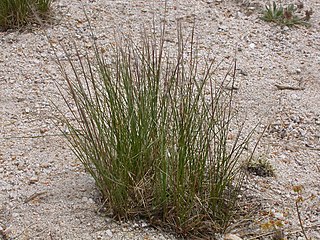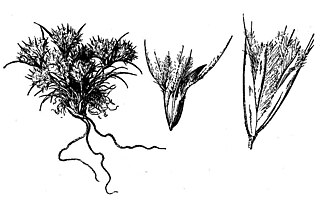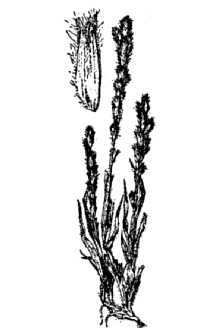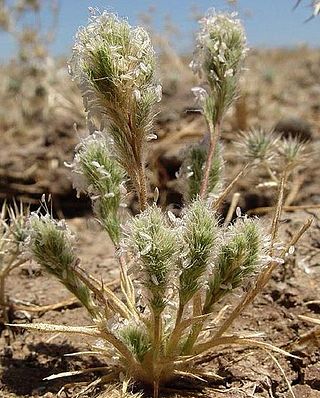The grass Tuctoria mucronata, which is known by several common names including prickly spiralgrass, Solano grass, and Crampton's tuctoria, is a federally listed endangered plant species endemic to two counties in northern California.

Swallenia is a rare genus of plants in the grass family, found only in Death Valley National Park, California.
Great Valley Grasslands State Park is a state park of California, United States, preserving a parcel of remnant native grassland in the San Joaquin Valley. Such a temperate grasslands, savannas, and shrublands biome was once widespread throughout the whole Central Valley. The 2,826-acre (1,144 ha) park was established in 1982. Largely undeveloped, it was formed by combining two former state park units: San Luis Island and Fremont Ford State Recreation Area. Its chief attractions for visitors are spring wildflowers, fishing, and wildlife watching.

Tuctoria greenei is a species of grass endemic to California. Its common names include awnless spiralgrass and Greene's tuctoria. It is included by the California Native Plant Society on list 1B.1. It is also listed by the state of California as rare and by the Federal Government as endangered, having been federally listed on March 26, 1997.

Eriocoma latiglumis is a species of grass known by the common names wide-glumed needlegrass and Sierra needlegrass.

Eriocoma occidentalis is a species of grass known by the common name western needlegrass. It is native to western North America from British Columbia to California, Colorado, and Arizona and in northeastern Mexico (Chihuahua), where it grows in many types of habitat.

Blepharidachne kingii is a species of grass known by the common name King's eyelashgrass. It is native to the Great Basin in the United States, where it grows in habitat such as pinyon-juniper woodland. It is rare in California and Idaho, but it is one of the most common grasses of the northeastern deserts of Nevada.

Chloropyron palmatum is an endangered species of salt-tolerant, flowering plant in the family Orobanchaceae. It is a low, highly branched herbaceous annual with each flower enclosed by a single, characteristically palmate bract. It is known by the common names of palmate salty bird's-beak and palmate-bract bird's-beak.
Eryngium pinnatisectum is an uncommon species of flowering plant in the family Apiaceae, known by the common names Tuolumne eryngo and Tuolumne button celery.
Eryngium racemosum is a rare species of flowering plant in the family Apiaceae known by the common name delta eryngo, or delta button celery.
Juncus triformis is an uncommon species of rush known by the common names Yosemite dwarf rush and long-styled dwarf rush.

Lomatium caruifolium, known by the common name alkali desertparsley, is a species of flowering plant in the carrot family.

Tuctoria is a genus of three species of grass in the family Poaceae. Spiralgrass is a common name for plants in this genus. These are bunchgrass species that are found in vernal pools of central California and Baja California, Mexico. The plants are annuals that germinate under water in the spring and grow submerged for weeks. After the pools dry down, the grasses initiate a new set of foliage that lasts for one to two months until flowering and fruiting are complete.
Orcuttia inaequalis is a rare species of grass known by the common name San Joaquin Valley Orcutt grass.

Orcuttia pilosa is a rare species of grass known by the common name hairy Orcutt grass.

Orcuttia viscida is a rare species of grass known by the common name Sacramento Orcutt grass.

Packera breweri is a species of flowering plant in the aster family, Asteraceae. It is known by the common name Brewer's ragwort. It is endemic to central California, where it occurs in the woodlands and grasslands of the Central Coast Ranges. They are more frequently found in mid-southern counties of California near the coast, such as Kern or Monterey.

Sidalcea calycosa is a species of flowering plant in the mallow family known by the common names annual checkerbloom, checker mallow, and vernal pool checkerbloom.
Trifolium bolanderi is a species of clover known by the common names Bolander's clover and parasol clover.
Navarretia ojaiensis is a rare species of flowering plant in the phlox family known by the common name Ojai navarretia.












